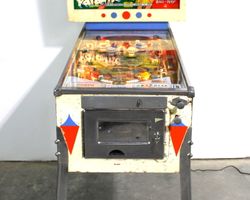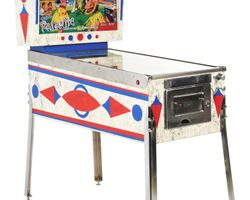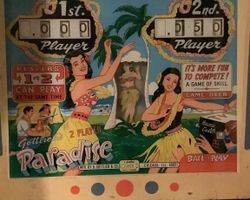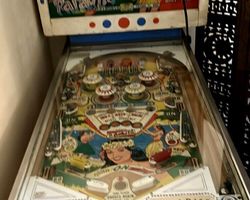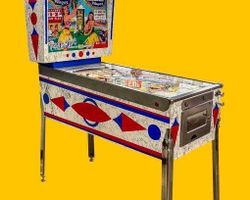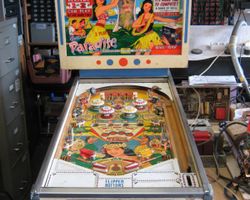Paradise
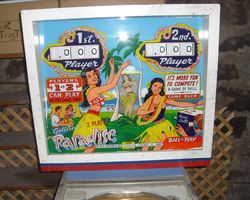
Average Prices: USD $600 to $2,000
Produced: November, 1965
Production Run: 2,100 units
Machine Type: Electro-mechanical
Players: 2
Design by: Ed Krynski
Art by: Roy Parker
"Paradise," an electro-mechanical (EM) pinball machine from D. Gottlieb & Co., emerged in November 1965, offering players a vibrant escape into a Hawaiian-inspired world. With a production run of 2,100 units, this two-player game quickly established itself with a distinct identity. The creation of "Paradise" was a collaborative effort, predominantly shaped by Ed Krynski, who was responsible for the machine's overall design, concept, animation, and mechanical engineering. The visual character of "Paradise" was brought to life by artist Roy Parker, whose work consistently defined Gottlieb's aesthetic during this period.
Gottlieb, known for its consistent output of engaging EM titles, aimed to capture the allure of tropical getaways with "Paradise." The machine's theme is an ode to the relaxed, idyllic imagery associated with Hawaii, from its sun-drenched beaches to its vibrant culture. A notable historical detail surrounding "Paradise" concerns its playfield innovation. It was among the first Gottlieb designs to incorporate flipper return lanes, wireforms that guide the ball behind the slingshot directly to a waiting flipper. While designed with this feature, production schedules shifted, leading to another Gottlieb title, "Bank-A-Ball," being released earlier with these new lanes. This minor resequencing in production does not diminish "Paradise's" place as a foundational design in the evolution of pinball playfield geometry.
Signature Features and Design
"Paradise" distinguishes itself with several captivating elements that enhance both its visual appeal and gameplay experience. A central draw is the mechanical backbox animation featuring a hula dancer. This animated figure sways gently with each chime from the game, imbuing the machine with a whimsical, living quality that complements the tropical theme. While the dancer's movement is subtle, it provides a consistent, charming visual accompaniment to gameplay, adding a layer of delight for players and spectators.
Another distinctive feature is the under-playfield projection roto unit. This mechanism integrates directly into the game's scoring system, creating a dynamic and unpredictable element as it rotates. This rotating unit, tied to specific playfield targets, influences the values players can achieve, adding depth to strategic shot-making.
Roy Parker's artwork is intrinsic to the machine's allure. The playfield and backglass burst with bright, inviting colors, depicting cheerful Hawaiian figures and lush tropical scenery. This artistic style, characterized by its clean lines and appealing character designs, establishes a family-friendly aesthetic that invites players of all ages. The bright palette and thematic consistency across the machine’s art package contribute significantly to the overall immersive experience, transporting players to the machine’s namesake setting. The classic Gottlieb chimes and the robust mechanical noises that accompany gameplay further ground the experience, providing a satisfying auditory feedback loop characteristic of EM machines.
Playfield and Mechanics
The "Paradise" playfield is a carefully arranged space designed to encourage strategic shot-making and sustained engagement. At the core of the layout are four relay kick-out holes, arranged in a stepladder progression. Hitting these holes sequentially advances their score value, culminating in higher rewards for completing the series. This design encourages players to aim for specific targets, fostering a sense of progression and a clear objective.
Central to the playfield is a row of four "ABCD" ball capture holes, which interact with the under-playfield roto unit. Successfully navigating the ball into these holes dictates how points are awarded, as the roto unit shifts the value assignments, adding an element of dynamic strategy. Around these central features, five standup targets offer additional scoring opportunities, contributing to the overall challenge and rewarding precision.
The playfield is populated with four pop bumpers and two slingshots, common elements in EM design that provide chaotic ball movement and increase the pace of play. The slingshots in "Paradise" are positioned somewhat higher on the playfield compared to some other machines of the era, which gives them a unique feel and requires players to adapt their nudging and flipper techniques. The two flippers are responsive, though their mechanical linkage requires a firm press, a characteristic trait of 1965 machines. The interplay of these elements, from the predictable stepladder progression to the rotating roto display, creates a flow that rewards both direct shots and controlled nudging. The vibrant artwork, infused with tropical motifs, is not merely decorative; it clearly delineates scoring areas and paths, enhancing player understanding and immersion.
Gameplay Dynamics
"Paradise" offers a gameplay experience that balances direct objectives with a degree of delightful unpredictability. The primary scoring mechanic revolves around the stepladder kick-out holes. Players are incentivized to hit these holes in sequence, as each successful capture advances the potential score. Achieving the highest value on these holes often leads to extra balls or special awards, creating a clear objective for high-score pursuits.
The interaction with the ABCD holes and the under-playfield roto unit adds a layer of depth. As the roto unit spins, the scoring value assigned to each ABCD hole changes. This introduces a strategic element where players must adapt their shots based on the current scoring configuration, or attempt to influence the roto's position through other playfield interactions. This dynamic scoring system ensures that no two games feel identical, encouraging repeated plays as players attempt to master the shifting values.
For two-player games, "Paradise" introduces an element of competitive interaction. The design allows players to "steal" bonuses from opponents, adding a compelling layer of direct competition. This feature transforms a simple high-score chase into a more engaging back-and-forth contest, making it a popular choice for shared play. Despite the mechanical reels displaying a maximum of 1,999 points per player (with an additional light for 1,000 points), the game's capacity for high scores and replay awards up to 15 replays on the replay wheel provides ample opportunity for extended play sessions. The game demands precise flipper control and a keen understanding of nudging, as ball momentum and positioning are crucial for hitting the higher-value targets and navigating the unique slingshot placement. Its pace, while slower than modern solid-state machines, is part of its charm, allowing for deliberate shot planning and the appreciation of its mechanical nuances.
Reception and Legacy
"Paradise" has garnered a positive reception within the pinball community, often described as a classic with enduring appeal. Its primary strengths are consistently cited as its distinctive artwork, the charming backbox animation, and its unique gameplay mechanics. The visual design, with its bright colors and inviting Hawaiian theme by Roy Parker, is frequently praised for its beauty and the cheerful atmosphere it creates. The hula dancer animation, while subtle in motion, contributes significantly to the machine’s character, offering a visual reward that reinforces the thematic elements.
Players also appreciate the strategic depth offered by the stepladder kick-out holes, which provide a clear sense of progression and reward skillful play with increasing point values and opportunities for extra balls. The unique under-playfield roto unit, tied to the ABCD holes, adds an element of dynamic scoring that keeps gameplay fresh. As a two-player experience, "Paradise" stands out, with the ability to influence or "steal" opponent bonuses adding a competitive edge that encourages head-to-head play. The classic Gottlieb chimes and the satisfying mechanical sounds contribute to an overall sensory experience that many find nostalgic and engaging.
However, "Paradise" is not without its noted aspects. The three-digit score display, common for its era, is sometimes mentioned as a limitation, as players can achieve scores well beyond 1,999 points, requiring them to track cumulative thousands via a separate light. The placement and feel of the slingshots, higher on the playfield and not as close to the flippers as some players might prefer, present a different challenge that requires adaptation. Some players perceive the hula dancer's movement as having limited direct gameplay payoff, though its value is more in aesthetic charm than immediate score impact. The flipper buttons, typical for EM machines of the 1960s, may feel "stiff" compared to later designs, demanding a firmer press. While some appreciate the game's slower pace for its strategic depth, a few find it can occasionally lead to less frantic action than desired. Despite these minor points, the general consensus is overwhelmingly positive.
"Paradise" holds a place as a representative example of Gottlieb's electro-mechanical prowess in the mid-1960s. Its innovative use of playfield features, such as the early incorporation of flipper return lanes (even if not the very first to market), demonstrates Gottlieb's continuous experimentation with gameplay mechanics. Its enduring popularity stems from its balance of visual appeal, engaging playfield design, and the satisfying mechanical experience. It remains a sought-after machine for collectors and enthusiasts who value the artistry and ingenuity of vintage pinball, solidifying its legacy as a cherished classic within the hobby.
Sponsored Links
 Ebay Listings
Ebay Listings
 Auction Results
Auction Results
| Cost | Location | Date |
|---|---|---|
| USD $1,500 |  North Carolina, United States North Carolina, United States |
20 April, 2025 |
| USD $2,100 |  California, United States California, United States |
20 April, 2025 |
| USD $2,300 |  Arizona, United States Arizona, United States |
15 October, 2024 |
| USD $900 |  Nevada, United States Nevada, United States |
13 April, 2024 |
| USD $750 |  Maryland, United States Maryland, United States |
12 October, 2023 |
| USD $2,000 |  California, United States California, United States |
14 August, 2022 |
| USD $425 |  Texas, United States Texas, United States |
29 September, 2021 |
| USD $2,000 |  Maryland, United States Maryland, United States |
12 February, 2020 |
| EUR €1,499 |  Baden-Württemberg, Germany Baden-Württemberg, Germany |
20 September, 2019 |
| USD $1,750 |  Washington, United States Washington, United States |
02 March, 2019 |


Private Policy · Search Website · Contact Us
As an eBay Partner, we may earn a commission from qualifying purchases made through links on this site, at no additional cost to you.
All trademarks and copyrighted materials remain property of their respective owners. All other content copyright 2007 - 2026 Pinpedia.

